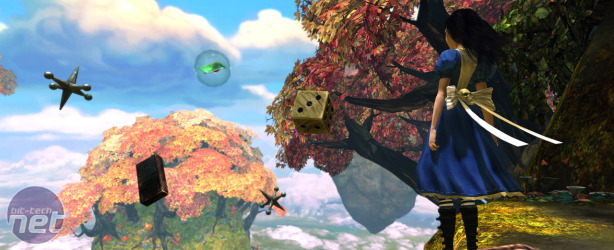
Alice: Madness Returns Review
Publisher: Electronic ArtsPlatform: PC, Xbox 360, PlayStation 3
UK Price (as reviewed): £30.99 (inc VAT)
US Price (as reviewed): $29.99 (ex tax)
American McGee may have a reputation as a bit of an egoist for the way he’s plastered his unusual name all over his previous games, but it’s a reputation that few would attempt to deny him. Ever since his days of working on the original Doom, McGee has worked on some of the most visually inventive – if not always mechanically solid – videogames.
Madness Returns is, it turns out, no exception. Part Lewis Carroll, part Tim Burton and part fantastic; Alice is a tour de force of artistry and near-mechanical faultlessness. Near faultlessness – a case of so close, yet not quite meeting absolute brilliance.
The problem does not lie with the visuals or the plotting, which are as sublime as you might imagine, even if they do spend a lot of time riffing off the themes of the original American McGee’s Alice. The story begins with Alice laid on the psychiatrist’s couch in a muted, grimy version of Victorian England, re-rendered with a Schindler’s List palette. The dialogue is oddly placed and the vocals strangely flat on occasion, but after a few minutes this starts to add to the charm – Alice wanders through the streets and listens to onlookers damn her or letch after her with a curious sense of unreality.
Soon enough, Wonderland calls and thus the rhythm of the game is established as Alice flits between her hallucinations and the real world, which is no less grim or sensible. Things have changed in Wonderland, and while she's there Alice must try to unravel her psychological state in a search for inner peace, while at the same time dealing with other problems in the real world.
The structure of the story makes Psychonauts an obvious reference, though truth-be-told Psychonauts is a viable comparison for a whole load of other reasons too. Not only does it share a similar level of aesthetic awesomeness and a theme about exploring the minds of characters, but it also bears the same strengths and weaknesses. Alice even has slides that are analogous to Psychonauts’ slippery rails.
It’s Alice’s nearness to greatness that most makes Psychonauts such a relevant reference, however. Both titles are primarily platform games that empower players to explore fantastic landscapes with improbable tools, but both falter when it comes to making these tools as usable as they should be. Alice’s movements are often visually striking and delightful to control, but occasionally at the expense of accuracy or control.
Check the Game Trailers section for more videos
Alice’s dodge, for example, is one of the game's most consistently enjoyable actions and sees the troubled girl evaporate into a swarm of butterflies before reappearing a second later. Not only is this incredibly pretty, but it’s useful too as Alice’s window of intangibility enables her to avoid blows with arguably too much ease. When pulled into jumping puzzles, however, dodging is more problematic – basically because Alice’s momentary invisibility makes it hard to gauge where she might land after a mid-air evaporation. The same is true for Alice’s other airborne moves – glides that use her skirt as a parachute for limited distances, and double jumps that only stack with difficulty or furious button mashing.
The beauty of all these movements shines through these small control issues, however, especially when Alice’s strength and grace in Wonderland is contrasted with her real-world limitations and awkwardness.

MSI MPG Velox 100R Chassis Review
October 14 2021 | 15:04











Want to comment? Please log in.